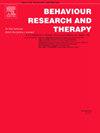日常生活中重复的消极思维预测精神病理:生态瞬间评估范式的进一步验证
IF 4.5
2区 心理学
Q1 PSYCHOLOGY, CLINICAL
引用次数: 0
摘要
重复性消极思维(RNT)是一个重要的跨诊断过程,参与了精神病理的发展和维持。在之前的研究中,我们开发了一种生态瞬时评估(EMA)范式来评估日常生活中的RNT。本研究旨在复制和扩展早期关于EMA范式的可靠性和有效性的发现,包括对未来心理健康的预测。在探索性分析中,研究了基于ema的RNT的动态模式(如应力反应性RNT、变异性、惯性和不稳定性)的预测效用。方法220名学生在学期开始的10天内,每天5次在智能手机上完成基于ema的RNT评估。在学期结束时,学生们在高压力时期填写了同样的问卷。结果过程相关RNT量表在EMA中具有较高的信度和效度。此外,基于ema的RNT在三个月后显著预测抑郁和焦虑症状,高于基线症状和特质RNT。在动态RNT参数中,RNT的不稳定性和变异性显著高于平均的基于ema的RNT。讨论结果支持日常生活中RNT过程相关测量的信度和效度,但不支持混合测量。此外,我们的研究结果表明,基于ema的RNT的动态模式比平均基于ema的RNT更能增强对精神病理的预测。由于测试的是同质学生样本,因此研究结果的普遍性是有限的。本文章由计算机程序翻译,如有差异,请以英文原文为准。
Repetitive negative thinking in daily life predicts psychopathology: Further validation of an ecological momentary assessment paradigm
Background
Repetitive negative thinking (RNT) is an important transdiagnostic process involved in the development and maintenance of psychopathology. In a previous study, we developed an Ecological Momentary Assessment (EMA) paradigm to assess RNT in daily life. This study aimed to replicate and extend earlier findings on the reliability and validity of the EMA paradigm, including the prediction of future mental health. In exploratory analyses, the predictive utility of dynamic patterns of RNT, such as stress-reactive RNT, variability, inertia, and instability of EMA-based RNT was investigated.
Methods
220 students filled out questionnaires (trait RNT, mental health-related measures) and completed the EMA-based RNT assessment five times daily for ten days on smartphones at the start of their semester. At the end of the semester, students filled out the same questionnaires during a high stress period.
Results
The reliability and validity of a process-related RNT scale for use in EMA was confirmed as it showed high reliability within and between persons. Furthermore, EMA-based RNT significantly predicted symptoms of depression and anxiety after three months over and above baseline symptoms and trait RNT. Of the dynamic RNT parameters, RNT instability and variability significantly predicted psychopathology over and above mean EMA-based RNT.
Discussion
Findings support the reliability and validity of the process-related measure of RNT in daily life, but not the hybrid measure. In addition, our results suggest that dynamic patterns of EMA-based RNT enhance the prediction of psychopathology beyond mean EMA-based RNT. Generalizability of findings is limited as a homogenous student sample was tested.
求助全文
通过发布文献求助,成功后即可免费获取论文全文。
去求助
来源期刊

Behaviour Research and Therapy
PSYCHOLOGY, CLINICAL-
CiteScore
7.50
自引率
7.30%
发文量
148
期刊介绍:
The major focus of Behaviour Research and Therapy is an experimental psychopathology approach to understanding emotional and behavioral disorders and their prevention and treatment, using cognitive, behavioral, and psychophysiological (including neural) methods and models. This includes laboratory-based experimental studies with healthy, at risk and subclinical individuals that inform clinical application as well as studies with clinically severe samples. The following types of submissions are encouraged: theoretical reviews of mechanisms that contribute to psychopathology and that offer new treatment targets; tests of novel, mechanistically focused psychological interventions, especially ones that include theory-driven or experimentally-derived predictors, moderators and mediators; and innovations in dissemination and implementation of evidence-based practices into clinical practice in psychology and associated fields, especially those that target underlying mechanisms or focus on novel approaches to treatment delivery. In addition to traditional psychological disorders, the scope of the journal includes behavioural medicine (e.g., chronic pain). The journal will not consider manuscripts dealing primarily with measurement, psychometric analyses, and personality assessment.
 求助内容:
求助内容: 应助结果提醒方式:
应助结果提醒方式:


